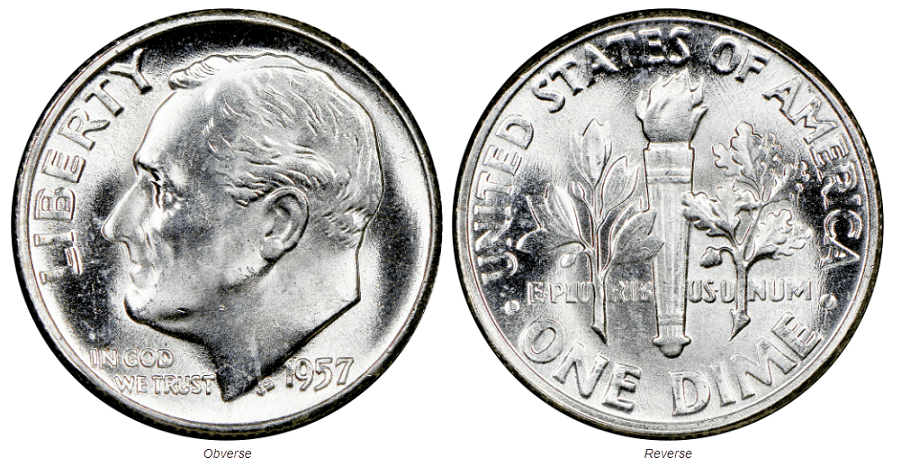Do you want to know more about the historical background, composition, design, and value of the 1957 dime? If yes, then you came to the right place. In this post, you’ll improve your knowledge about the Roosevelt dime issued in 1957 and ensure you make the right decision before buying or selling this coin.
What Is the 1957 Roosevelt Dime Made Of?
photo source: NGC
The 1957 dime is part of the Roosevelt dime series issued in 1957. Since this coin is old and is made of silver, it should be a nice addition to your collection.
When it comes to composition, the 1957 dime is made of 90% silver and 10% copper. It has a diameter of 17.9 millimeters, a weight of 2.5 grams, and a value of 10 cents.
Historically, the Roosevelt dime started to enter circulation in 1946, a year after the passing of Franklin D. Roosevelt. It was quite a disheartening death for the fallen leader since Roosevelt didn’t live to see the end of World War II when the United States and its allies won.
The dime was chosen as a tributary coin for Roosevelt since the 32nd president was a prime mover for establishing the March of Dimes organization.
Regarding design, the obverse features the left-facing image of Roosevelt. Inscriptions are also included, which are the following:
- LIBERTY
- IN GOD WE TRUST
- 1957
- Designer’s initials
On the reverse, you’ll find three images: the olive branch, Liberty Torch, and oak branch. On top arches the inscription, “UNITED STATES OF AMERICA.” Below the coin arches the denomination of the coin, “ONE DIME.” The US motto, “E PLURIBUS UNUM,” runs across the back of the coin.
The designer of the 1957 Dime is John R. Sinnock. However, there’s an ongoing debate that the original designer was Selma Burke. No matter who designed the 1957 dime, there’s no doubt that it is one of the most enduring designs in US coin history.
1957 Roosevelt Dime Varieties
The 1957 Roosevelt dime has three varieties. The designs in these varieties are essentially the same except for the mint mark and whether they are proof or standard struck.
Here’s a quick look at the varieties of 1957 dimes as well as their mintage:
| Variety | Mint Location | Mintage |
| 1957 D Roosevelt Dime | Denver | 113,354,330 |
| 1957 P Roosevelt Dime | Philadelphia | 160,060,000 |
| 1957 Proof Roosevelt Dime | Philadelphia | 1,247,952 |
| Total | 274,662,282 |
The US Mint produced more than 274 million dimes in 1957. This is a higher mintage compared to the mintage figure in 1956 and 1958.
Check out the details below, which will give you more information about the 1957 dime varieties:
1957 D Roosevelt Dime
Year of minting: 1957
Mint Mark: D
Place of minting: Denver
Quantity produced: 113,354,330
Face Value: $0.10 (ten cents)
Price: $2.10 to $2.60 (circulated condition)
Mass: 2.50 grams
Edge: Reeded
Designer: John R. Sinnock
Composition: 90% Silver and 10% Copper
Diameter: 17.90 millimeters
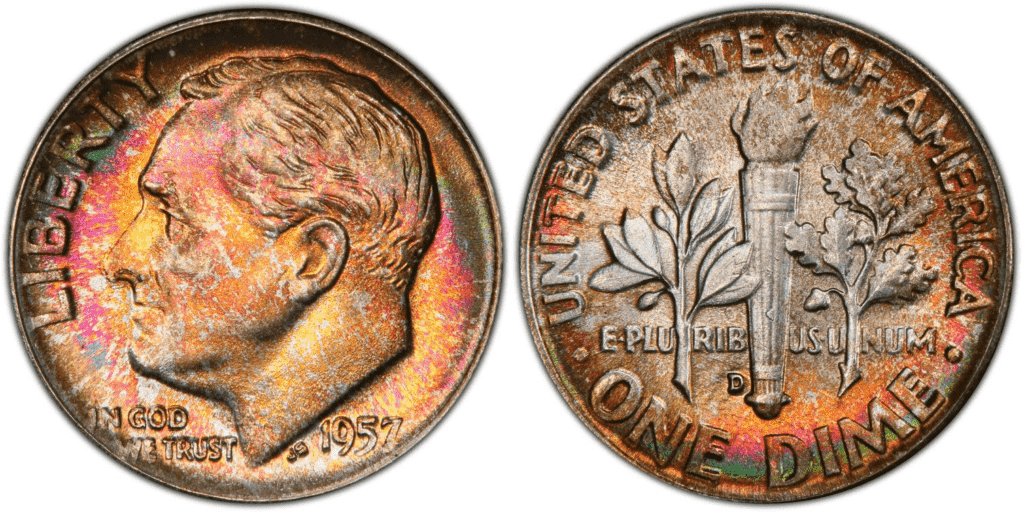
The Denver Mint produced more than 113 million dimes in 1957, more than in 1956 by the same mint center. Because of the hoarding of 1957 D dimes, you should easily find examples in Mint State up to MS 67.
1957 P Roosevelt Dime
Year of minting: 1957
Mint Mark: none
Place of minting: Philadelphia
Quantity produced: 160,060,000
Face Value: $0.10 (ten cents)
Price: $2.10 to $2.60 (circulated condition)
Mass: 2.50 grams
Edge: Reeded
Designer: John R. Sinnock
Composition: 90% Silver and 10% Copper
Diameter: 17.90 millimeters
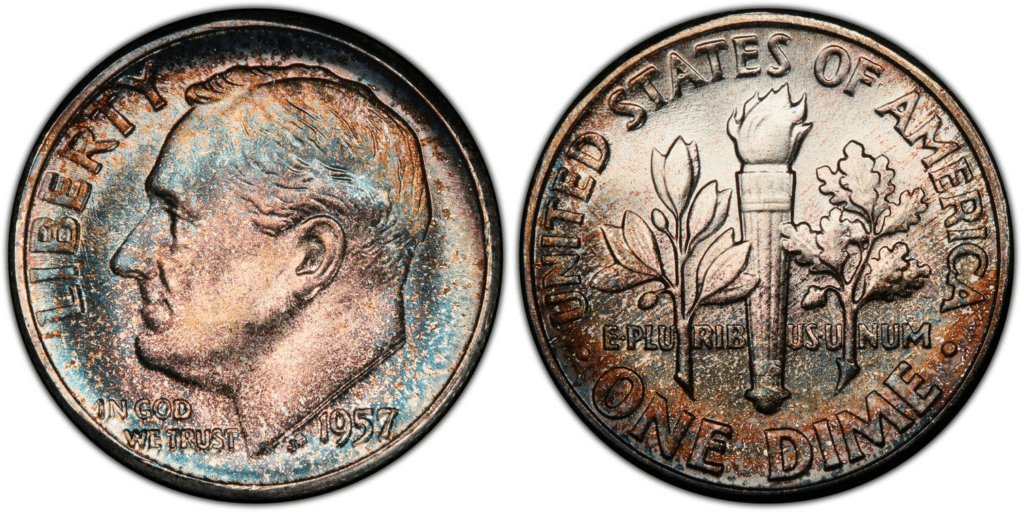
What is so interesting about the 1957 P dime is the mintage.
There was a sudden surge in dime production in 1957. Notice that in 1957, the Philadelphia Mint produced more than 160 million dimes. Compare that to the mintage in 1956, which is about 109 million.
You should easily find Mint State gems up to MS 67, but coins with Full Band (Full Torch) designation are scarce.
1957 Proof Roosevelt Dime
Year of minting: 1957
Mint Mark: none
Place of minting: Philadelphia
Quantity produced: 1,247,952
Face Value: $0.10 (ten cents)
Price: $13 or more (uncirculated condition)
Mass: 2.50 grams
Edge: Reeded
Designer: John R. Sinnock
Composition: 90% Silver and 10% Copper
Diameter: 17.90 millimeters
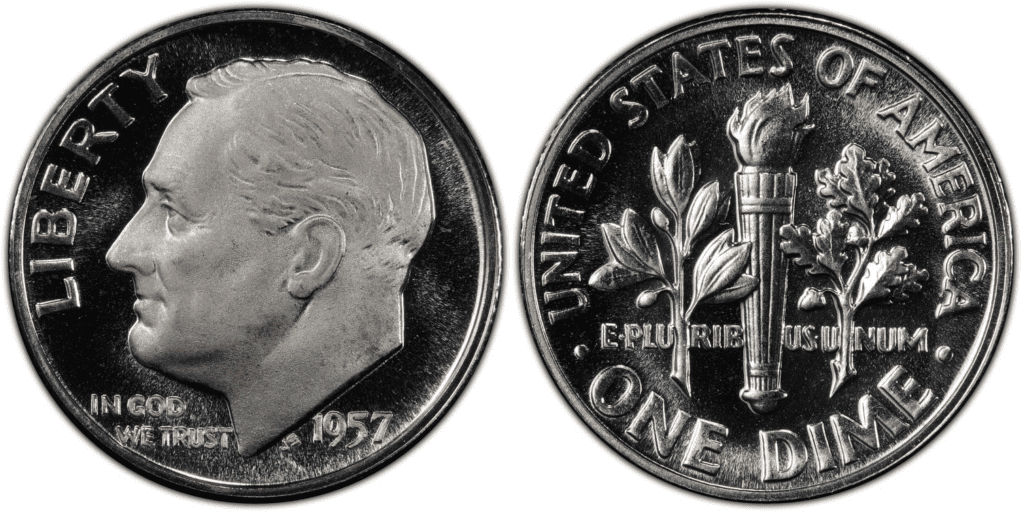
The Philadelphia Mint produced more than 1.2 million proof dimes in 1957. This shows you the high demand for proof dimes.
Because of the better minting techniques and technology in producing proof dimes, you should easily find examples in Mint State. However, dimes with cameo and deep cameo designations are difficult to find and may even be more expensive.
List Of 1957 Roosevelt Dime Errors
There are millions of 1957 Roosevelt dimes, and because of that, there’s always the chance for error coins to appear. Error coins may sound negative, but many coin collectors love to have this. After all, error coins can be rare and unique simultaneously.
Here are some of the most common 1957 Roosevelt dime errors that you should know:
Clipped planchet
The planchet should be perfectly cut and shaped. It should also have the right thickness. However, the planchet gets clipped because of the problem in feeding the metal.
Here’s an example of a clipped planchet error in a 1957 dime:
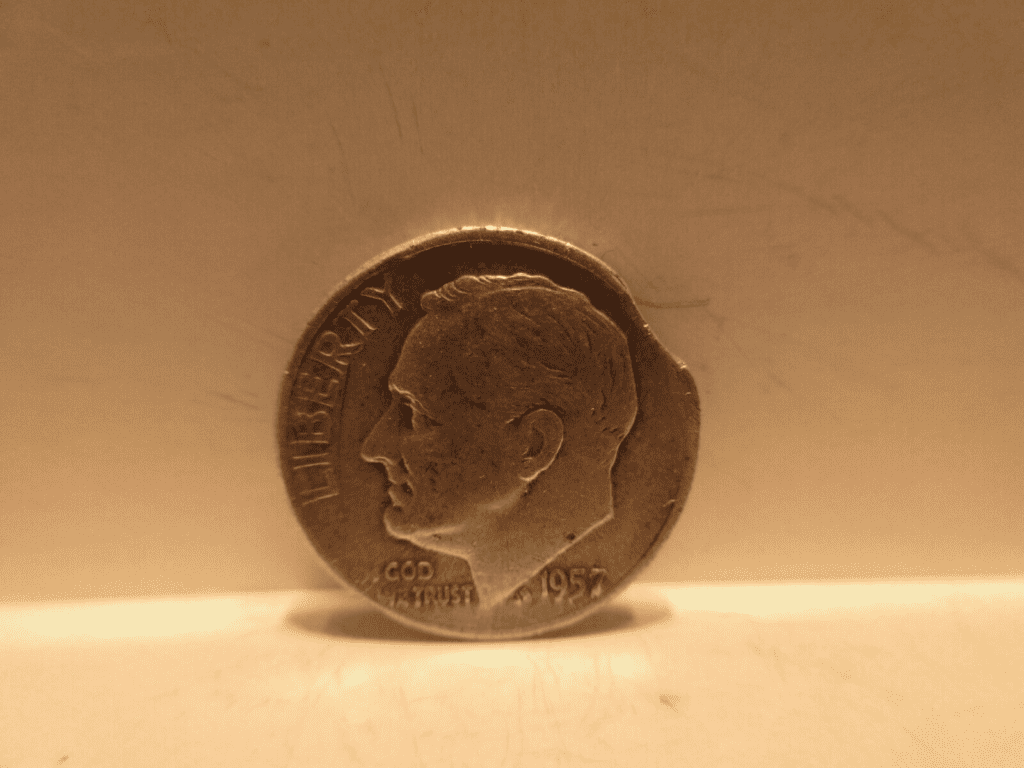
Doubled die error
Doubled die error is when the planchet is struck twice. When this happens, the second strike produces a doubling effect on different places on the coin’s engraved elements. The doubling can usually be seen on the inscribed letters or numbers.
For numismatists, doubled die errors can cause the value of a coin to increase. The more prominent the error is, the higher the value.
Repunched mint mark
Another example of an error in 1957 dimes would be the repunched mint mark or RPMs. This error happens when the mint mark, in this case, the letter D, is punched to the planchet twice.
In repunched mintmark, the letter D would look doubled. Like the doubled die error, collectors value the coins more with more obvious RPM errors.
How Much Is 1957 Roosevelt Dime Worth Today?
The 1957 Roosevelt dime has a face value of 10 cents. However, since it has silver, it can be traded at a higher price. At the time of this writing, the melt value is $1.59. This can increase or decrease depending on the value of silver in the market. If you’re going to sell or buy a circulated 1957 Roosevelt dime, you’re looking at a price of $2.10 to $2.60.
If you want to know the earning potential of 1957 Roosevelt dimes, it is worth looking at the table below, which shows you the auction records for each variety:
| Coin | Condition | Grade | Sold date | Sold by | Value |
| 1957 Proof Roosevelt Dime | Superb Gem Uncirculated | PR 69 – Deep Cameo | January 8, 2014 | Heritage Auctions | $4,113 |
| 1957 D Roosevelt Dime | Superb Gem Uncirculated | MS 67 (Full Band) | January 1, 2009 | Superior Galleries | $4,025 |
| 1957 P Roosevelt Dime | Superb Gem Uncirculated | MS 67 (Full Band) | July 11, 2013 | Heritage Auctions | $2,233 |
How Does The Grading System Work?
Coin grading of the 1957 dime follows the same system used in other types of US coins.
Numismatists use the Sheldon Scale to provide a numerical value to coins. The Sheldon Scale goes from poor (P-1) to perfect mint state (P-1) (MS-70). Coins were originally evaluated using words to reflect their condition (Good, Fair, Excellent, Etc.). Unfortunately, coin collectors and dealers had different ideas about what each of these terms represents.
Professional numismatists joined together in the 1970s and established CoinGrading standards. These numismatists now assign grades at key places on the seventy-point scale, using the most regularly utilized numeric points in conjunction with the original adjective grade. The following are the most common coin grades:
- (P-1) Poor – Indistinguishable and probably damaged; if used, must have a date and mintmark; otherwise, rather battered.
- (FR-2) Fair – Nearly smooth, but without the damage that a coin graded Poor often possesses. The coin must have enough detail to be identified.
- (G-4) Fair – Inscriptions have merged into the rims in some areas, and important elements have been mostly erased.
- (VG-8) Very Good- A little weathered, but all primary design elements are visible, albeit faintly. There is little, if any, central detail left.
- (F-12) Good – The item is very worn, yet the wear is even, and the overall design details stand out clearly. Rims are almost completely isolated from the field.
- (VF-20) Very Fine – Moderately weathered, with some finer features still visible. The motto or all letters of LIBERTY are readable. Both sides of the coin have entire rims separated from the field.
- (EF-40) Extremely Fine – Gently used; all gadgets are visible, and the most important ones are bold. The finer details are bold and clear; however, light wear may be seen.
- (AU-50) Uncirculated – Slight evidence of wear on the coin’s design’s high points; it may have contact marks; eye appeal should be adequate.
- (AU-58) Uncirculated Choice – Slight traces of wear, no severe contact marks, almost full mint shine, and great eye appeal.
- (MS-60) Mint State Basal – Strictly uncirculated; no indication of wear on the coin’s highest points, but an unsightly coin with reduced luster, visible contact marks, hairlines, and other flaws.
- (MS-63) Mint State Acceptable – Uncirculated, but with contact scratches and nicks, little reduced shine, but otherwise appealing appearance. The strike is weak to average.
- (MS-65) Mint State Choice – Uncirculated with great mint shine, little contact blemishes, and exceptional eye appeal. The strike is unusually severe.
- (MS-68) Mint State Premium Quality – Uncirculated with superb luster, no obvious contact marks to the naked eye, and exceptional eye appeal. The strike is quick and appealing.
- (MS-69) Almost Perfect Mint State – Uncirculated with perfect brilliance, a sharp and appealing strike, and extremely good eye appeal. A near-perfect coin with minor imperfections in the planchet, strike, and contact markings (seen only under 8x magnification).
- (MS-70) Mint State Perfect – Under 8x magnification, no tiny imperfections are discernible; the strike is crisp, and the coin is perfectly centered on a beautiful planchet. Rarely seen on a coin, this coin is bright and whole, with original luster and exceptional eye appeal.
Moreover, 1957 dimes would be given the designation of “Full Band” (PCGS) or “Full Torch” (NGC). Various coin-grading service providers use different terms, but they mean the same. If your 1957 dime gets the designation Full Band, it is fully and properly struck, displaying a more detailed look of the engraved materials.
If the contrast between the background and engraved materials is detailed for proof coins, it can be called Cameo and Deep Cameo. (Note, NGC uses the term Ultra Cameo instead of Deep Cameo.)
Where To Buy Or Sell 1957 Roosevelt Dime?
The 1957 Roosevelt dimes are available online and offline. If you want to quickly and easily find 1957 dimes, then the Internet would be your best bet.
A simple Google search should give you a lot of helpful results. Type “Where to buy 1957 Roosevelt dime” or “Where to sell 1957 Roosevelt dime.” You should then find websites that will help.
Some of the top websites you should consider would be eBay, Amazon, and Etsy. There are also specialized websites for coin buying and selling. These websites may include USA Coin Book, Grey Sheet, and Coin Trackers.
Aside from the Internet, try coin shops where many coin varieties exist. Other places might not commonly offer coins, but you can try them. These include pawnshops and antique stores.
FAQs
How much is a 1957 dime no mint mark worth?
The 1957 dime with no mint mark is worth around $1 to $3, depending on the condition of your coin. Circulated coins are cheaper compared to uncirculated coins. For example, a 1957-proof Roosevelt dime was sold for $4,113 on January 8, 2014.
Does a 1957 dime have silver?
Yes, the 1957 dime has silver. It is made of 10% copper and 90% silver.
Where is the mint mark on a 1957 dime?
The mint mark on a 1957 dime is found on the left side of the torch’s base. The mint mark is D since Philadelphia Mint didn’t add a mintmark.

